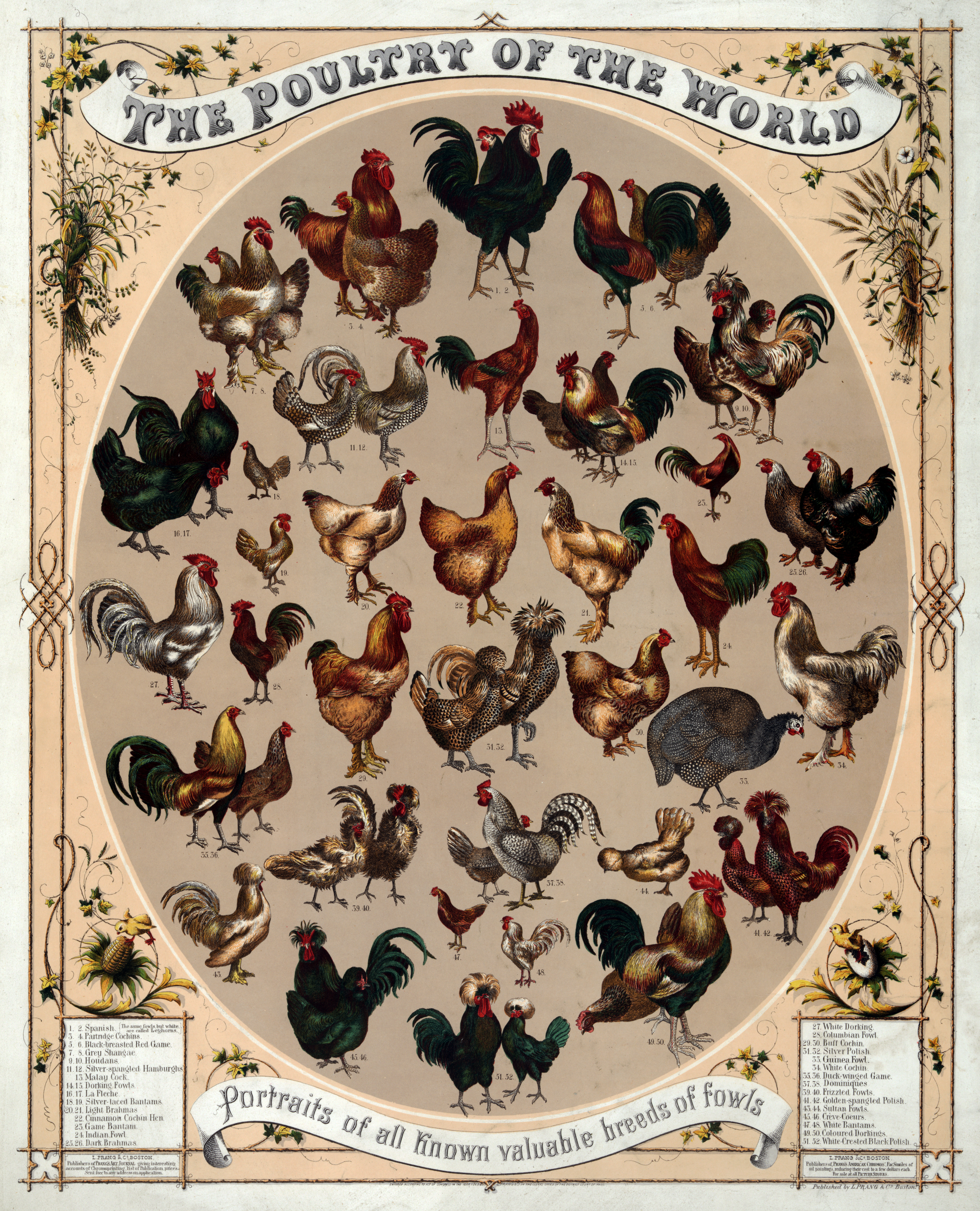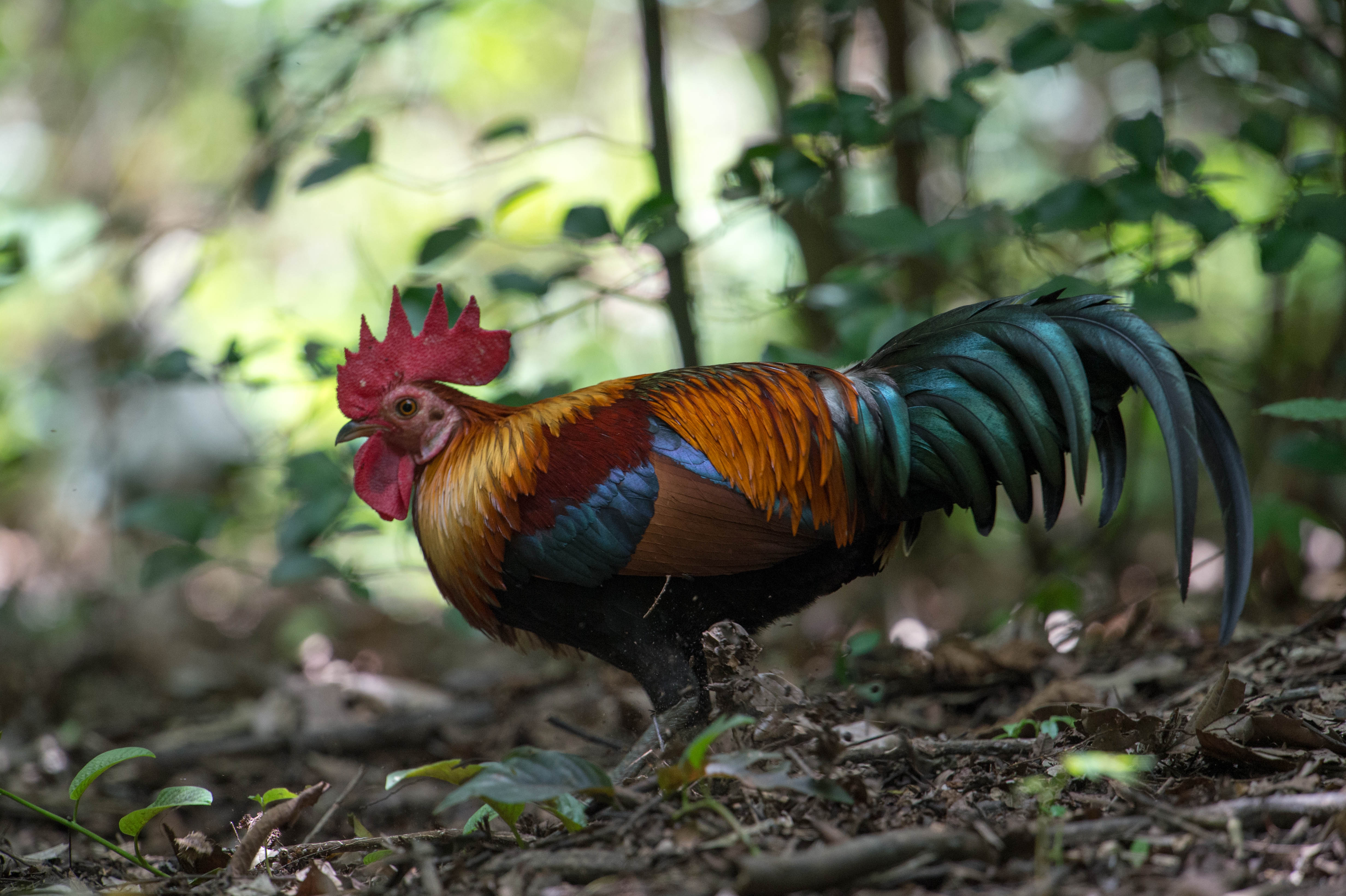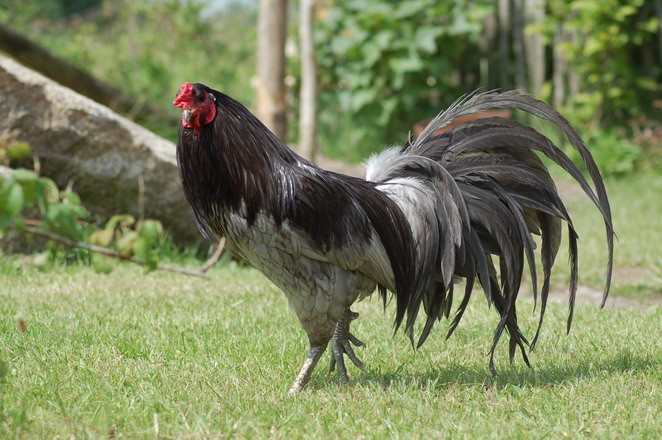|
Ostfriesische Möwe
The (, ) is an old German breed of domestic chicken. It is a rare breed: in 2016 the recorded population in Germany consisted of 215 cocks and 979 hens, in the hands of 130 breeders. Its conservation status is , "endangered". History The Möwe derives from the traditional rural chickens of north-western Germany and north-eastern Holland, in East Friesland East Frisia () or East Friesland (; ; ; ) is a historic region in the northwest of Lower Saxony, Germany. It is primarily located on the western half of the East Frisian peninsula, to the east of West Frisia and to the west of Landkreis Fries ... and West Friesland respectively. It is closely related to the Westfälische Totleger and the Braekel. Characteristics It is kept in two colour varieties: silver-pencilled and gold-pencilled. Cocks weigh up to and hens up to Hens lay about 170 eggs per year, averaging in weight. References Ostfriesische MöweOstfriesische Möwe Chicken breeds originating i ... [...More Info...] [...Related Items...] OR: [Wikipedia] [Google] [Baidu] |
Chicken
The chicken (''Gallus gallus domesticus'') is a domesticated subspecies of the red junglefowl (''Gallus gallus''), originally native to Southeast Asia. It was first domesticated around 8,000 years ago and is now one of the most common and widespread domesticated animals in the world. Chickens are primarily kept for chicken as food, their meat and egg as food, eggs, though they are also kept as pets. As of 2023, the global chicken population exceeds 26.5 billion, with more than 50 billion birds produced annually for consumption. Specialized breeds such as broilers and laying hens have been developed for meat and egg production, respectively. A hen bred for laying can produce over 300 eggs per year. Chickens are social animals with complex vocalizations and behaviors, and cultural references to chickens, feature prominently in folklore, religion, and literature across many societies. Their economic importance makes them a central component of global animal husbandry and agricu ... [...More Info...] [...Related Items...] OR: [Wikipedia] [Google] [Baidu] |
Groninger Meeuw Zilverpel Hen
The Groninger or Groningen is a Dutch horse breed developed for light draft and agricultural work. It is closely related to heavy warmblood breeds like the East Friesian and Alt-Oldenburger. The breed was nearly lost in the mid-20th century because a significant number of mares were used for crossbreeding to create the Dutch Warmblood, leaving few purebreds. History Foundation The Groninger shares much of its initial foundation with the Friesian, East Friesian and Alt-Oldenburger, and Holsteiner: small native farm horses and medieval destriers were influenced by popular Spanish, Neapolitan, and Arabian horses in the 17th and 18th centuries. Horses like England's Cleveland Bay were also utilized, producing a horse that was tall by the standards of the day, as well as reasonably elegant with deep, wide haunches and a thick, high-set neck. Although selection procedures had been in use for many years, the first Dutch horse registries weren't founded until the late 19th and e ... [...More Info...] [...Related Items...] OR: [Wikipedia] [Google] [Baidu] |
Mouette Frise Orientale Naine , Swiss transport organization
{{disambig ...
Mouette is a French word for seagull (cognate to mew). It can refer to: * La Mouette, French aircraft manufacturer * , French automobile company in the 1920s * Operation Mouette, 1953 French military operation in Vietnam * The name given to the Stadler FLIRT train sets for SBB Switzerland See also * Mouettes, commune in Eure, Haute-Normandie * Mouettes Genevoises Navigation ''Mouettes Genevoises Navigation'' is a private Water taxi, water bus operator in Geneva, Switzerland, operating four lines across the western end of Lake Geneva. A member of the integrated Unireso fare network, its head office is in Geneva. The m ... [...More Info...] [...Related Items...] OR: [Wikipedia] [Google] [Baidu] |
List Of Chicken Breeds
There are hundreds of chicken breeds in existence. Domesticated for thousands of years, distinguishable breeds of chicken have been present since the combined factors of geographical isolation and Selective breeding, selection for desired characteristics created regional types with distinct physical and behavioral traits passed on to their offspring. The physical traits used to distinguish chicken breeds are size, plumage color, Comb (anatomy), comb type, skin color, number of toes, amount of feathering, Egg (biology), egg color, and place of origin. They are also roughly divided by primary use, whether for eggs, meat, or ornamental purposes, and with some considered to be dual-purpose. In the 21st century, chickens are frequently bred according to predetermined breed standards set down by governing organizations. The first of such standards was the British Poultry Standard, which is still in publication today. Other standards include the Standard of Perfection, the Australian Po ... [...More Info...] [...Related Items...] OR: [Wikipedia] [Google] [Baidu] |
Chicken
The chicken (''Gallus gallus domesticus'') is a domesticated subspecies of the red junglefowl (''Gallus gallus''), originally native to Southeast Asia. It was first domesticated around 8,000 years ago and is now one of the most common and widespread domesticated animals in the world. Chickens are primarily kept for chicken as food, their meat and egg as food, eggs, though they are also kept as pets. As of 2023, the global chicken population exceeds 26.5 billion, with more than 50 billion birds produced annually for consumption. Specialized breeds such as broilers and laying hens have been developed for meat and egg production, respectively. A hen bred for laying can produce over 300 eggs per year. Chickens are social animals with complex vocalizations and behaviors, and cultural references to chickens, feature prominently in folklore, religion, and literature across many societies. Their economic importance makes them a central component of global animal husbandry and agricu ... [...More Info...] [...Related Items...] OR: [Wikipedia] [Google] [Baidu] |
Conservation Status
The conservation status of a group of organisms (for instance, a species) indicates whether the group still exists and how likely the group is to become extinct in the near future. Many factors are taken into account when assessing conservation status: not simply the number of individuals remaining, but the overall increase or decrease in the population over time, breeding success rates, and known threats. Various systems of conservation status are in use at international, multi-country, national and local levels, as well as for consumer use such as sustainable seafood advisory lists and certification. The two international systems are by the International Union for Conservation of Nature (IUCN) and The Convention on International Trade in Endangered Species of Wild Fauna and Flora (CITES). International systems IUCN Red List of Threatened Species The IUCN Red List of Threatened Species by the International Union for Conservation of Nature is the best known worldwide conse ... [...More Info...] [...Related Items...] OR: [Wikipedia] [Google] [Baidu] |
East Friesland
East Frisia () or East Friesland (; ; ; ) is a historic region in the northwest of Lower Saxony, Germany. It is primarily located on the western half of the East Frisian peninsula, to the east of West Frisia and to the west of Landkreis Friesland. Administratively, East Frisia consists of the districts Aurich, Leer and Wittmund and the city of Emden. It has a population of approximately 469,000 people and an area of . There is a chain of islands off the coast, called the East Frisian Islands (). From west to east, these islands are Borkum, Juist, Norderney, Baltrum, Langeoog and Spiekeroog. History The geographical region of East Frisia was inhabited in Paleolithic times by reindeer hunters of the Hamburg culture. Later there were Mesolithic and Neolithic settlements of various cultures. The period after prehistory can only be reconstructed from archaeological evidence. Access to the early history of East Frisia is possible in part through archaeology and in part through ... [...More Info...] [...Related Items...] OR: [Wikipedia] [Google] [Baidu] |
West Friesland (historical Region)
West Friesland () is a contemporary region in the Northwest of the Netherlands, in the province of North Holland. History The River Vlie (also called Fli), is an extension of the IJssel branch of the Rhine River. The river divides the northern Netherlands into two parts, the western and the eastern part. In the eleventh century, heavy rainfall caused the river to flood over large parts of the land. The Zuiderzee bay (previously a lake called Lacus Flevo by Roman authors) was formed, separating West Friesland from the contemporary Province of Friesland. In the Middle Ages, the Westflinge area of West Friesland became an island, bordered on the north by the Medem and Zijpe inlets, and to the south by various interconnecting lakes (now polder land) that were connected with the Zuiderzee. Because of this, the toponym "West Friesland" was applied more to the Westflinge area than to the original West Friesland. For approximately 300 years, West Friesland operated as an auton ... [...More Info...] [...Related Items...] OR: [Wikipedia] [Google] [Baidu] |
Braekel
The Braekel or Brakel is a traditional Belgian List of chicken breeds, breed of chicken. It is thought to have originated in the area of Brakel, Belgium, Brakel, in the Flemish Region, Flemish Provinces of Belgium, province of East Flanders, for which it is named. There is a bantam (poultry), bantam version of the Braekel. The Campine (chicken), Campine of the United Kingdom derives from it. History The Braekel apparently derives from same extended population of gold and silver chickens which gave rise to the closely similar Ostfriesische Möwe and Westfälischer Totleger breeds. It is thought to have originated in the area of Brakel, Belgium, Brakel, in the Flemish Region, Flemish Provinces of Belgium, province of East Flanders, and particularly in the villages of Opbrakel and Nederbrakel; and to have spread along the valleys of the Scheldt and Dender rivers, in East Flanders and into Hainaut Province, Hainaut. In 1884, two distinct types were recognised as separate breeds ... [...More Info...] [...Related Items...] OR: [Wikipedia] [Google] [Baidu] |
List Of Chicken Colours
{{bots, deny=Citation bot ...
Breeders and fanciers of chickens accurately describe the colours and patterns of the feathers of chicken breeds and varieties. This is a list of the terms used in this context. Self Self-coloured chickens are those which display one solid colour without patterning of any kind. Barred and cuckoo Columbian, belted Duckwing Laced Pencilled Mottled, spangled, mille fleur Black-tailed Black-breasted Others References Chickens Bird colours Chicken plumage patterns Poultry Chicken The chicken (''Gallus gallus domesticus'') is a domesticated subspecies of the red junglefowl (''Gallus gallus''), originally native to Southeast Asia. It was first domesticated around 8,000 years ago and is now one of the most common and w ... [...More Info...] [...Related Items...] OR: [Wikipedia] [Google] [Baidu] |
Chicken Breeds Originating In Germany
The chicken (''Gallus gallus domesticus'') is a domesticated subspecies of the red junglefowl (''Gallus gallus''), originally native to Southeast Asia. It was first domesticated around 8,000 years ago and is now one of the most common and widespread domesticated animals in the world. Chickens are primarily kept for chicken as food, their meat and egg as food, eggs, though they are also kept as pets. As of 2023, the global chicken population exceeds 26.5 billion, with more than 50 billion birds produced annually for consumption. Specialized breeds such as broilers and laying hens have been developed for meat and egg production, respectively. A hen bred for laying can produce over 300 eggs per year. Chickens are social animals with complex vocalizations and behaviors, and cultural references to chickens, feature prominently in folklore, religion, and literature across many societies. Their economic importance makes them a central component of global animal husbandry and agricu ... [...More Info...] [...Related Items...] OR: [Wikipedia] [Google] [Baidu] |





